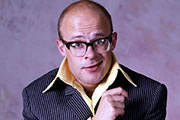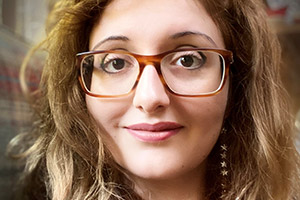A look back at Harry Hill's endearingly bonkers Channel 4 show
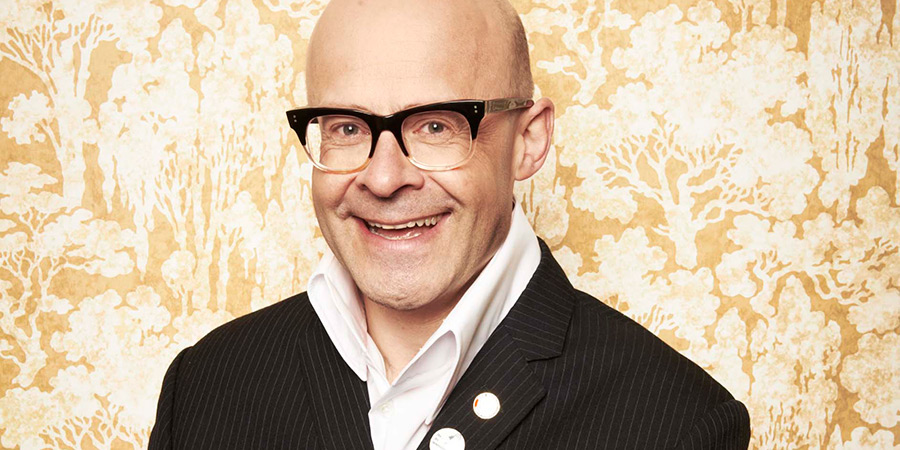
In what you could call the surreal comedy renaissance of the late nineties - where Vic & Bob tore up the scene with their Big Night Out and Chris Morris brought us a whole new level of dead-pan absurdity in The Day Today - Harry Hill's late 90s Channel 4 show ultimately became the much-overlooked jewel in the crown of alternative comedy TV programmes.
It was a slice of madcap humour that really was unlike anything that had come before, and although Harry Hill's name is far more associated with the megahit TV Burp that followed a few years later, it is the old Channel 4 format - simply titled Harry Hill - that has always remained a firm favourite amongst the comedian's fans.
Matthew Hall, performing under the stage name Harry Hill, gained attention and recognition in the early nineties for his innovative and above all surreal stand-up. Naturally his success on the circuit propelled him to his own Radio 4 series: Harry Hill's Fruit Corner, which began in 1993. It was a mix of stand-up, sketches, songs and special guests.
Harry attracted some surprisingly big names to the series, for a young comic. Comedy alumni joining the show included Richard Briers, Ronnie Corbett and two Doctor Who stars (Jon Pertwee, Peter Davison). The show was introduced each week, often to the cry 'The man from the fruit corner, he say, Yes!', and then Harry came on to perform what was essentially a stand-up set which seamlessly slipped into sketches and chat with the supporting cast.
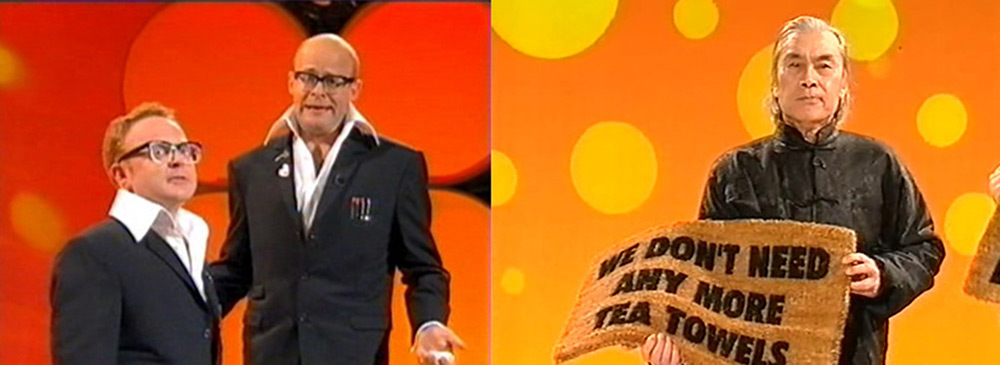
The original idea was that we were listening to Harry Hill accompanied by his entire family; which consisted of a mum, a dad, his big brother Alan (Al Murray), Nana Hill, Martin (who had an onion obsession) and Harry's tiny adopted three-year-old son, little Alan.
Little Alan Hill was played by Matt Bradstock-Smith, Harry's old friend from his time as a medical student. He never spoke in the series, as he didn't feel comfortable with delivering lines; nonetheless, he did get a spot on the payroll. Harry remarked in his autobiography that Matt was one of radio's few silent actors as he only communicated via tapping (one tap for yes, two for no, etc.). Despite his small role, invisible to the public at large, Bradstock-Smith was instrumental in getting Harry Hill on stage, and as a result Harry was determined to involve him in the series by any means possible.
As time went on, the format of Fruit Corner changed slightly, with a new focus on Harry's relationship with Burt Kwouk. After appearing as a special guest in the second series, Harry and Burt struck up an unlikely friendship. For the following two series he became a regular on the show. Harry would set Burt the task of catching a chicken, which he would invariably fail to do. 'Harry! I will catch me that chicken!' Burt would often shout before breaking into a chorus of the 1941 Harry Roy song, Hey Little Hen.
By the end of Fruit Corner's run, it had transformed into the blueprint for the Channel 4 series, with many sketches already firmly in place that would become mainstays of the TV series. Often, we would hear Kwouk's weekly search for a chicken and accompanying song; Harry reading the news as Zeinab Badawi; and the regular appearance of Harry's chief scientist, Finsbury Park, usually on a mission to sort out the mute little Alan. Most bizarre of all was the Ben Kingsley clown union sketch - Clown 4290 - which saw Harry Hill go into full Goon Show mode.
The sketch featured a Czechoslovakian clown soap opera with Al Murray as Coco and Harry as Jojo. Typically, Coco would propose doing something fairly mundane yet circus related, which the clowns weren't allowed to do according to "official union rules". To this proposition of clown rule breaking Jojo would reply, 'But what if Ben Kingsley, clown union finds out?' Coco would then rebuke him, 'Aww, he never find out!'. Ben Kingsley would then walk in causing Jojo to throw his hands up and cry out 'Ohhhh Coco!' and then, quite naturally, the Crossroads theme would play.
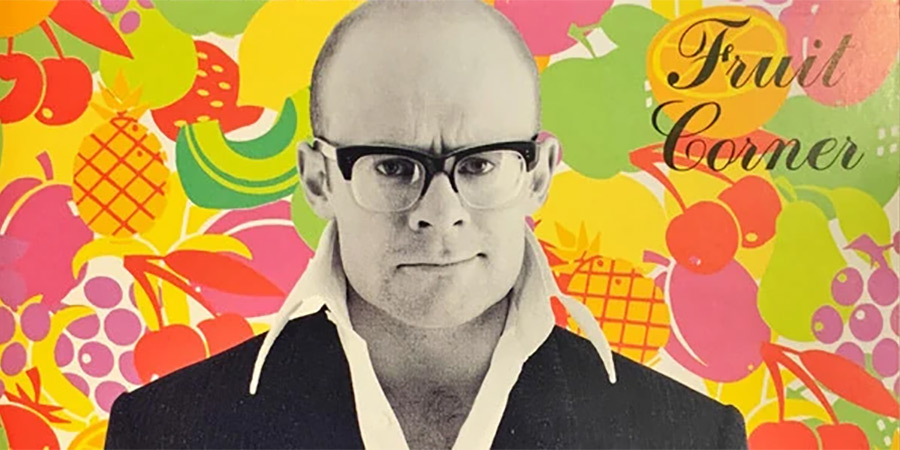
In the final episode of Fruit Corner, Harry (apparently terminally ill with "Ospreys") asks Al Murray's Big Brother Alan if they can perform Clown 4290 one last time. He replies:
"You know Harry, that in all the high-level meetings we've had about Fruit Corner with the new head of radio comedy, Tony Hadley... he explained that because Clown 4290 is so unpopular with the listening public, whenever we play it so many people turn off that there's actually a surge of excess electricity and he keeps burning his toast."
It was this kind of daft self-awareness that seemed to strike a chord, and Fruit Corner continued to gain cult success over its four years on Radio 4. Yet, despite his repeated attempts to bring the show to TV, Harry was told by both the BBC and Channel 4 that his show would 'in no way work on the television'. However, this changed after Harry bagged a regular spot on ITV's 1996 answer to Friday Night Live, Saturday Live. Although this spin on the classic eighties stand-up showcase only lasted for one series, it was Harry Hill that made a big impact. Suddenly he was offered a brand-new TV show, he could do whatever he wanted... and that was exactly what he did. He brought Fruit Corner to television with big plans, ambitious concepts and no attempts whatsoever to tone down his surreal humour for mainstream audiences.
In realising his dream, Harry took inspiration from the comedy greats and his childhood heroes, such as Spike Milligan and the Pythons, but also, perhaps slightly more surprisingly, from the more traditional style of comedy offered by the mainstays of seventies television, such as Bruce Forsyth and The Two Ronnies. This was ultimately how he came to select Robin Nash as the director for the series.
Nash had been Head of Comedy at the BBC in the late eighties, producing some classic sitcoms such as Terry & June and Bread. His old-school experience was just what Harry wanted. He was keen for Harry Hill to look retro, he wanted it to feel like something from a by-gone era. He requested a set that looked fresh from the 1970s and wanted the show to be filmed in the same way that The Two Ronnies or The Morecambe & Wise Show had been shot, which was exactly what Robin Nash could authentically provide.
Harry Hill is a very visual performer, and with a look and performance style all ready to go, he took very naturally to television. It was Nash that encouraged Harry to "play the cameras" finding different angles to pack even more humour into his routines, which eventually lead to the classic side glances that became such a trademark of TV Burp. But in Harry Hill there was another unique visual element that set it apart: puppetry.
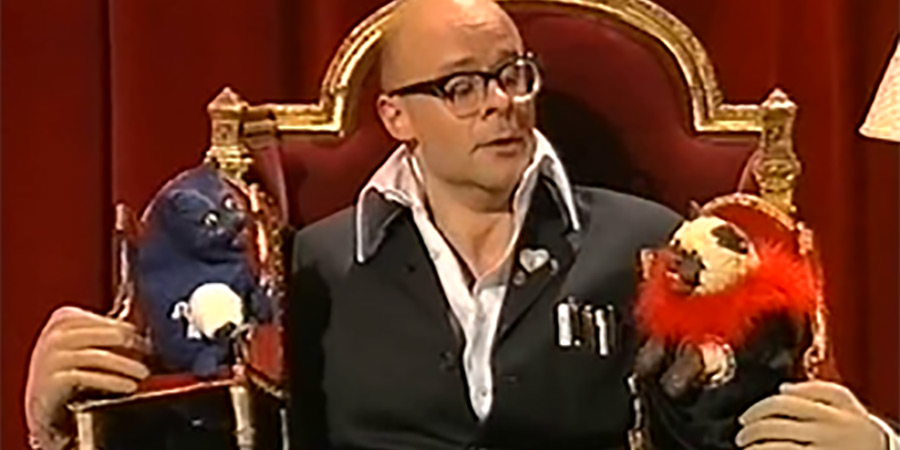
Almost half of the show's main characters were puppets, most famously, Stouffer, who was Harry's iconic blue cat. There was a cast of badgers named after celebrities of the day such as Tasmin Archer Badger and Gareth Southgate Badger. Even Keith Harris and Orville had recurring parts in the show. Orville ran a bar for all the puppets, in a sitcom sketch set-up much like Cheers. It was a place where Stouffer would be having a few drinks, while Gary, the Channel 4 Controller, whose wife had just left him (for Gary Wilmot) would think up ideas for ways that he too could be included in the show.
This was where the series went full on with its no-holds-barred madness. One episode of Orville's sketch saw Barrie Gosney as Ken Ford - the man from The Joy of Sex books (a character he regularly performed in the series) advising Stouffer about his new relationship. 'It's been a long time you know', Stouffer, the blue plastic cat puppet, tells Ken seriously. This sketch ends with Stouffer passing out at the sight of his naked girlfriend (another cat puppet) who then turns to the camera and sings, 'I know all there is to know about the crying game'. The audience's reaction makes it extra special; one woman can be heard absolutely screaming at the oddity of it.

As a whole, the series was a more adult version of The Muppet Show. Gary, the Controller of Channel 4, had a story arc which ran through the second series in which he became increasingly desperate to be included in the show. Gary was a very traditional looking ventriloquist's dummy. He would appear to be another callback to the traditional variety style of comedy, a sort of warped version of Archie Andrews from the popular 1950s radio series, Educating Archie (a puppet who bantered with comedy giants such as Eric Morecambe, Dick Emery, Harry Secombe and Tony Hancock, who were all at the start of their careers, whilst Peter Brough performed his ventriloquism act... on the radio).
But it was Stouffer that became the most beloved puppet of the series. He was a frankly odd-looking plastic cat, that was originally black, but Harry had him remade in blue for the TV series, thus an icon was born. Stouffer would sit astride a throne being supported by an obviously fake arm. The whole sketch was a kind of loose parody of variety acts such as Rod Hull and Emu. Harry would say, 'That's it Stouffer, you help me' whenever he quite obviously needed to use his hand through the puppet in order to open that week's fan letter. Initially, Channel 4 executives were confused by the whole concept and expressed concerns that in Harry's scenes with Stouffer you could see his mouth moving.
The duo's most famous sketch saw the pair count down various celebrities with big faces in a Top Of The Pops style (it was an early example of Hill's TV Burp savagery), 'He gotta big face!' Stouffer would shout, which became another catchphrase that stuck with the character, alongside the one he always signed off with, 'Sorted, respect due'.
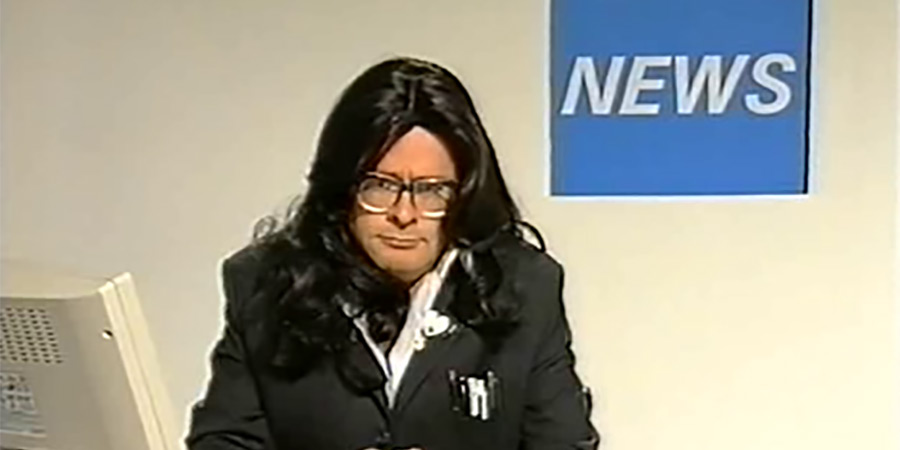
Bizarre lines and weird catchphrases were the things that defined the programme, but what really gave it an edge was the sheer pace of it. For example, this news reader sequence takes up less than thirty seconds of screen time:
Harry: [throws on a wig from behind a news desk]
Good evening, I'm Zeinab Badawi, and here is the news!
[shout/sings in a high-pitched voice]
CAMILLA PARKER-BOWLES! You like those biscuits, don't you?... The headlines: Swan - long neck, goose - long neck, Owl - short neck, that swivels round.
[He grabs the Stouffer puppet from under the desk]
He gotta big face!
[He throws him back under the desk; looks to the side camera]
I should have my own key though, shouldn't I?
[Turns back and plays the Grange Hill theme on the computer keyboard in front of him]
The line, 'I should have my own key though, shouldn't I?' delivered in a kind of lilting tone, is the cream of Harry Hill's style of comedy. Although this line had been a callback, its prelude being, 'Your mum polishing your shoes for the next morning... I'd be crazy to move out, wouldn't I?' the remark stands here on its own. It's one of those 'why is this funny?' lines. Most jokes can be pulled apart and explained, but a line like that, it's hard to describe why it works, yet coupled with the pleading look to the side camera, it's pure genius.
Elsewhere in the series Harry had a kind of sitcom with Burt, Harry and Burt at Home. Usually, these sketches would involve Harry's continuing obsession with Rory McGrath - typically Harry was the smart one, while Burt played the fool:
Burt: [sitting on his bunk bed sorting through his video tapes] I don't know which year is my favourite 'The Guns of Navarone', the 1976 'Guns of Navarone' was pretty good, but then so was the 1982 'Guns of Navarone'.
Harry: It's the same film every year Burt!
Their unique double act proved a winning combination as Burt continued to try and catch a chicken, performing Hey Little Hen each week. Three shows into the first series Burt told Harry, 'You know, I think something must be working. I used to get people saying "Not now Cato" on the tube, but this morning someone said to me, "have you caught that chicken yet?".'
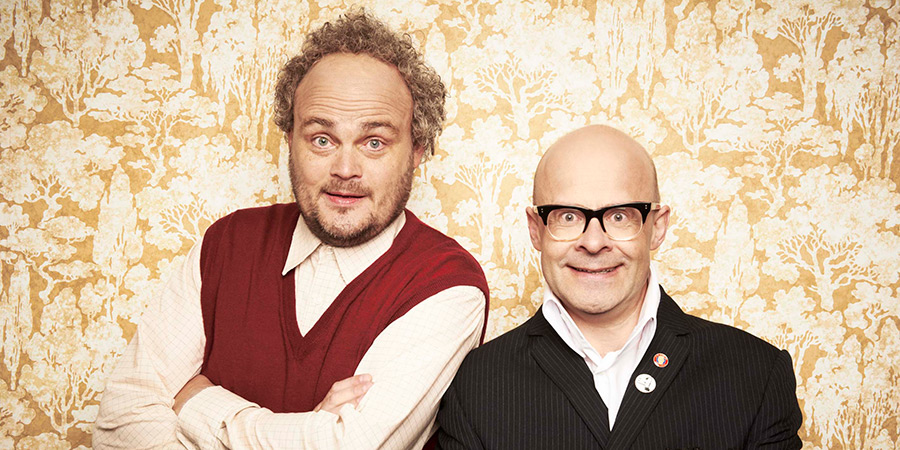
Another performer who shone brightly was Al Murray as Big Brother Alan. Harry and Al had a great comic chemistry between them. Murray, here in pre-Pub Landlord fame, was perfectly in tune with the style of the series. Big Brother Alan was the lovable idiot with a belt fetish who usually came on at the end of each show to break the news to Harry that the Badger Parade was off.
This Badger Parade was something Harry came up with whilst touring. He was in Liverpool and had become tired of performing his Savlon 2000 show. While on route to that night's gig, he caught sight of a charity shop window adorned with a load of badger puppets. 'Stop the car!' Harry yelled. After bartering with the shop assistant (who initially refused to sell them, as they were for display purposes only) she eventually relented and he bought them for 50p. That evening Harry announced a Badger Parade:
'During the Badger Parade this evening, please no sudden movements or flash photography as it may startle the badgers.'
At the end of the show Harry would drag his new puppets across the stage to some Oom-pah music. He noted that the crowd were suitably baffled and when people were overheard chatting about it at the stage door, he knew he was onto something.
However, in the TV show the Badger Parade never actually happens. In fact, the distinct lack of a Badger Parade was the main feature of the series, resulting in Alan, or the special guest star, informing Harry, 'You'd better get down that grooming bay!'. Harry would then confront the badgers - turning up in a trench coat and homburg hat, 'Man Alive!' he would declare as he arrived to see the badgers, usually in some way indisposed, and then, much like those iconic shows of the seventies, the episode would finish on a big song featuring that week's special guest star, but no actual parade.
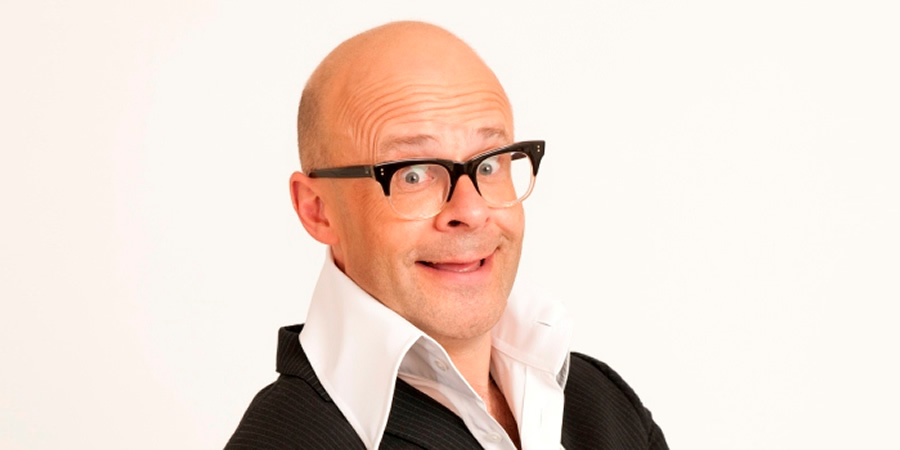
The choice of special guest was often as wacky as the humour, all sorts of random celebrities turned up, typically to perform snippets of covers that were wildly inappropriate for them. For instance, Chas 'n' Dave sang Blur, Ian Lavender sang Madonna, Peter Davison sang Pulp and Todd Carty played the movie themes on household appliances. But these were small segments dotted throughout the show, nowhere near as grand as the big finishing number.
The songs performed in the finale ranged from outright classics, to Eurovision standards, but most was the chart music of the day, making Harry Hill a delightful time capsule. One particularly memorable ending saw Harry perform Duran Duran's Planet Earth alongside Peter Baldwin with their heads suspended in spaceships. Another saw Harry ripping the skirts off giant badgers to Making your Mind Up, while Peter Davison was roped in to perform Pulp's Disco 2000 with the entire cast (including puppets) dressed as characters from Star Trek.
The series is a buoyant trip back to the nineties, a half hour of gorgeous nostalgia. However, when the star himself looked back on the series for his 2021 autobiography, he cast a much more critical eye over the show:
'At best they're patchy, and the third series is actually pretty ropey. It's never been repeated, you can't buy it on a DVD and I think that's probably for the best.'
Yet despite this dismissal, he held one particular special, or rather reunion of the show, in high regard. In 2012, Channel 4 was celebrating 30 years of broadcasting. They approached Harry about a TV special reviving the old series. At this time Harry had just ended TV Burp after ten long years. He had been exhausted by the show and was delighted to be leaving it behind. In truth, Harry had wanted to end TV Burp for years. The relentless schedule that was required of Harry and the team in order to build a programme up from nothing to a full, polished TV show in less than seven days was gruelling. Ten years is a very rare and lengthy run for any comedy series, it's almost unheard of in today's TV climate. But the news that the show was ending still came to the devastation of most. Everybody loved TV Burp and to this day people still regularly call for its return. Yet, as ground-breaking and instrumental as it was to the modern TV landscape (an argument could be made that British television became more self-aware and parodying in the years following TV Burp's success), Harry's innovative style of Goon Show bizarreness may ultimately have been stifled by the series.
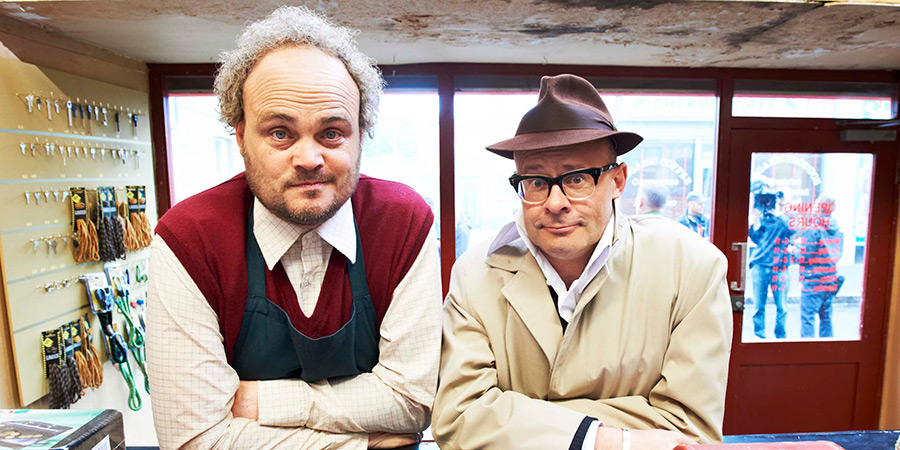
A few months after quitting, Harry spotted a demoralising article in Heat Magazine with the byline, 'Whatever Happened to Harry Hill?' It became the title for the reunion, which saw Harry, Burt, Al and Matt reunite after 13 years apart for a mockumentary reminiscing about the old Channel 4 series. When Harry went back down to that grooming bay for one last song, it was almost like the old gang had never been away. To see the badgers in full HD was a novelty, and of course, they still didn't want to do the parade. In fact, they had a few pointed words for him about the trappings of fame:
'We've had enough of the spotlight,' Gareth Southgate Badger told Harry.
'Fame is a mask that eats into your face,' Tasmin added.
This eventually led to the last big musical number, Price Tag by Jessie J, which saw the whole gang parody the line-up of judges on the TV talent show, The Voice.
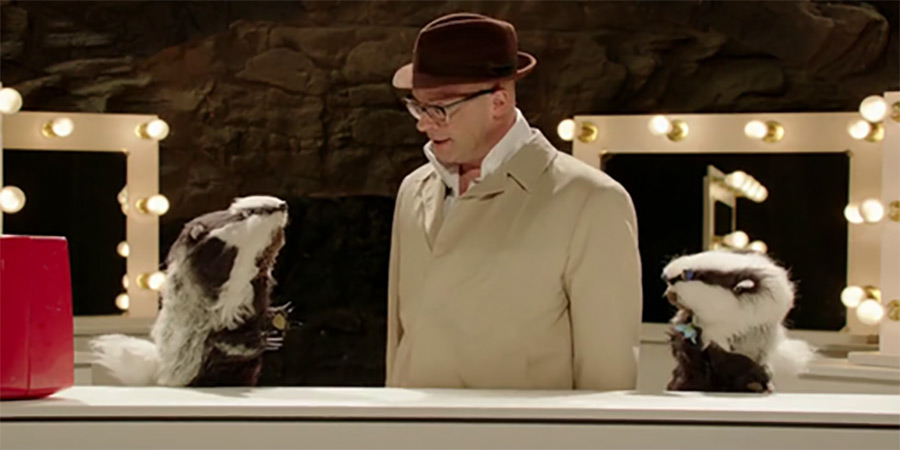
Harry's dear friend, Matt Bradstock-Smith, who had joined in with the reunion as a dancer in a mini skirt, passed away just 2 years later from cancer. Such was the closeness of the Harry Hill cast that Harry and Al both visited him in a hospice before he died. When Burt Kwouk passed away, Harry was asked to arrange his funeral, which he did so alongside Barry Cryer.
Harry Hill revealed in his autobiography that he was so very thankful that they had recorded that last reunion special when they did. In doing so they closed the book on one of the most endearingly bonkers series British comedy had ever seen, and quite possibly will ever see: the Channel 4 series simply known as Harry Hill.
Help us publish more great content by becoming a BCG Supporter. You'll be backing our mission to champion, celebrate and promote British comedy in all its forms: past, present and future.
We understand times are tough, but if you believe in the power of laughter we'd be honoured to have you join us. Advertising doesn't cover our costs, so every single donation matters and is put to good use. Thank you.
Love comedy? Find out more
